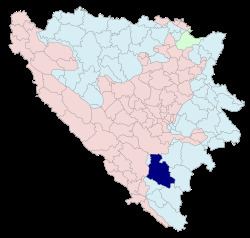Region East Herzegovina Area 923 km² Area code 59 | Time zone CET (UTC+1) Local time Saturday 4:58 AM | |
 | ||
Weather 4°C, Wind SE at 3 km/h, 100% Humidity | ||
Nata a s business boost for development of her hometown nevesinje
Nevesinje (Serbian Cyrillic: Невесиње) is a town and municipality in Bosnia and Herzegovina, located in eastern Herzegovina, between Mostar and Gacko. It is administratively part of the Republika Srpska entity.
Contents
- Nata a s business boost for development of her hometown nevesinje
- Map of Nevesinje Bosnia and Herzegovina
- Geography
- History
- Settlements in Nevesinje municipality 1991
- Transport
- Notable people
- References
Map of Nevesinje, Bosnia and Herzegovina
Geography
The municipality of Nevesinje is located in southern part of Bosnia and Herzegovina. This mountaneus municipality covers 1,040 km2 (402 sq mi) and average elevation is 860 m above the sea level. A large Karst plain dominates the municipality.
History
The annals of the Patriarchal Monastery of Peć mentioned Nevesinje in 1219, which is the earliest appearance of Nevesinje in preserved historical sources. The župa (county) of Nevesinje was held by Serbian prince Stefan Konstantin between 1303–06.
The Nevesinje region was under the rule of different medieval lords until the end of the 15th century. The most significant ruler of Nevesinje from this period was Stjepan Vukčić Kosača, known as Herceg Stefan. The whole land Hercegovina was named after him. His lands were under the constant threat from advancing Turkish forces in the 15th century. Hercegovina, and thus Nevesinje were gradually incorporated into the Turkish Empire by the first quarter of the 15th century (1422).
During the period of Turkish rule Nevesinje was mostly part of Bosnian Pashaluk and was a seat of a qadi. It was at Nevesinje that the Great Eastern Crisis was ignited, with the outbreak of the Herzegovinian rebellion of 1875-78 when Serbs of the region rebelled against Turkish tax collectors. The rebellion soon spread to the rest of Herzegovina and to Bosnia and other parts of the Ottoman Empire.
Neighbouring states, Serbia, Montenegro and Bulgaria got involved in the conflict which in turn pulled in great powers of the time. The conflict ended with Congress of Berlin in 1878 and the province of Bosnia and Herzegovina was placed under the administration of Austria-Hungary. At the same time Romania, Serbia, and Montenegro were declared independent principalities.
Settlements in Nevesinje municipality, 1991
There are 56 settlements in the Nevesinje municipality: Batkovići, Bežđeđe, Biograd, Bojišta, Borovčići, Bratač, Budisavlje, Donja Bijenja, Donji Drežanj, Donji Lukavac, Dramiševo, Gaj, Gornja Bijenja, Gornji Drežanj, Gornji Lukavac, Grabovica, Hrušta, Humčani, Jasena, Jugovići, Kifino Selo, Kljen, Kljuna, Kovačići, Krekovi, Kruševljani, Lakat, Luka, Miljevac, Nevesinje, Odžak, Plužine, Podgrađe, Postoljani, Presjeka, Pridvorci, Prkovići, Rabina, Rast, Rilja, Rogače, Seljani, Slato, Sopilja, Studenci, Šehovina, Šipačno, Trtine, Trusina, Udrežnje, Zaborani, Zalom, Zalužje, Zovi Do, Žiljevo, Žuberin and Žulja.
Transport
Nevesinje has a bus station and daily buses head from Nevesinje to Podgorica, Montenegro via the towns Gacko, Bileća and Trebinje within Bosnia and Herzegovina, and Nikšić and Danilovgrad within Montenegro. Local buses link the town with Mostar. The town also has direct buses to Dubrovnik and Belgrade.
